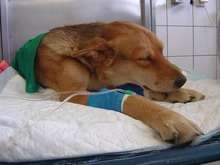Animal trypanosomiasis
Animal trypanosomiasis, also known as nagana and nagana pest, or sleeping sickness, is a disease of vertebrates. The disease is caused by trypanosomes of several species in the genus Trypanosoma such as Trypanosoma brucei. Trypanosoma vivax causes nagana mainly in West Africa, although it has spread to South America.[1] The trypanosomes infect the blood of the vertebrate host, causing fever, weakness, and lethargy, which lead to weight loss and anemia; in some animals the disease is fatal unless treated. The trypanosomes are transmitted by tsetse flies.[2]

An interesting feature is the remarkable tolerance to nagana pathology shown by some breeds of cattle, notably the N'Dama – a West African Bos taurus breed. This contrasts with the susceptibility shown by East African Bos indicus cattle such as the zebu.[3]
Transmission
Most trypanosomes develop in tsetse flies (Glossina spp.), in its biological vector, about one to a few weeks. When an infected tsetse fly bites an animal, the parasites are transmitted through its saliva. It can also be spread by fomites such as surgical instruments, needles, syringes. The most important vectors are thought to be horseflies (Tabanidae) and stable flies (Stomoxys spp.).
The immune response of animals could be unable to eliminate trypanosomes completely, and the animals could become inapparent carriers. These inapparent infections can be reactivated if the animal is stressed. Transplacental transmission can also occur.[4]
Signs and symptoms
The incubation period ranges from 4 days to approximately 8 weeks. The infection leads to significant weight loss and anemia. Various symptoms are observed, including fever, oedema, adenitis, dermatitis and nervous disorders. The disease cannot be diagnosed with certainty except physically detecting parasites by blood microscopic examination or various serological reactions.[5][6]
Vectors
| Disease | Species affected | Trypanosoma agents | Distribution | Glossina vectors |
|---|---|---|---|---|
| Nagana — acute form | antelope
cattle camels horses |
T. brucei brucei | Africa | G. morsitans
G. swynnertoni G. pallidipes G. palpalis G. tachinoides G. fuscipes |
| Nagana — chronic form | cattle
camels horses |
T. congolense | Africa | G. palpalis
G. morsitans G. austeni G. swynnertoni G. pallidipes G. longipalpis G. tachinoides G. brevipalpis |
| Nagana — acute form | domestic pigs
cattle camels horses |
T. simiae | Africa | G. palpalis
G. fuscipes G. morsitans G. tachinoides G. longipalpis G. fusca G. tabaniformis G. brevipalpis G. vanhoofi G. austeni |
| Nagana — acute form | cattle
camels horses |
T. vivax | Africa | G. morsitans
G. palpalis G. tachinoides G. swynnertoni G. pallidipes G. austeni G. vanhoofi G. longipalpis |
Control measures
If the outbreak is detected early, the organism can be destroyed by quarantines, movement controls, and maybe even put infected animals under euthanasia medication. Tsetse fly populations can be reduced or eliminated by traps, insecticides, and by treating infected animals with antiparasitic drugs. The tsetse habitat can be destroyed by alteration of vegetation so they can no longer live there. Some drugs can prevent trypanosomiasis, and are called prophylactic drugs. These are very effective in protecting animals during the times they are exposed to challenged diseases. Since they have been around for so long, some were not properly used which resulted in resistance to these drugs in some places.
References
- Batista JS, Rodrigues CM, García HA, Bezerra FS, Olinda RG, Teixeira MM, Soto-Blanco B (2011). "Association of Trypanosoma vivax in extracellular sites with central nervous system lesions and changes in cerebrospinal fluid in experimentally infected goats". Veterinary Research. 42 (63): 1–7. doi:10.1186/1297-9716-42-63. PMC 3105954. PMID 21569364.
- "Human African trypanosomiasis (sleeping sickness)". WHO.
- Courtin D, Berthier D, Thevenon S, Dayo GK, Garcia A, Bucheton B (May 2008). "Host genetics in African trypanosomiasis". Infect. Genet. Evol. 8 (3): 229–38. doi:10.1016/j.meegid.2008.02.007. PMID 18394971.
- "African Animal Trypanosomiasis" (PDF). The Center for Food Security and Public Health. Iowa State University. Retrieved 19 April 2017.
- "African Animal Trypanosomiasis" (PDF). The Center for Food Security and Public Health. Iowa State University. Retrieved 19 April 2017.
- Finelle, P. "African animal trypanosomiasis". Food and Agriculture Organization of the United Nations. Food and Agriculture Organization of the United Nations. Retrieved 19 April 2017.
Further reading
- WHO fact sheet on Trypanosomiasis
- Maré, C. J. (2005-10-14). "African Animal Trypanosomiasis". University of Georgia. Archived from the original on 2007-02-13. Retrieved 2007-02-14.
- Reduth, Dagmar; Grootenhuis, JAN G.; Olubayo, Reardon O.; Muranjan, Madhavi; Otieno-Omondi, Frederick P.; Morgan, Grant A.; Brun, Reto; Williams, Diana J. L.; Black, Samuel J.; et al. (2007). "African Buffalo Serum Contains Novel Trypanocidal Protein". The Journal of Eukaryotic Microbiology. 41 (2): 95–103. doi:10.1111/j.1550-7408.1994.tb01480.x. PMID 8167620.